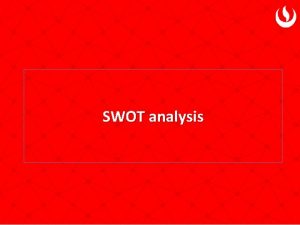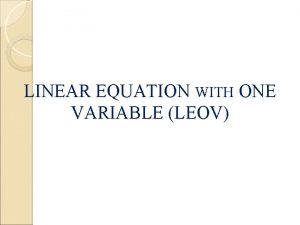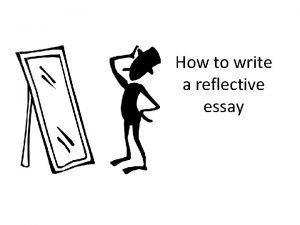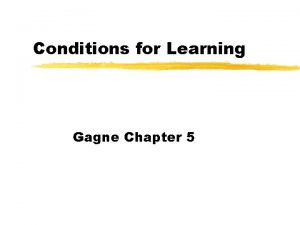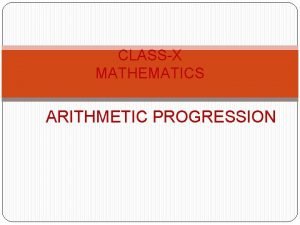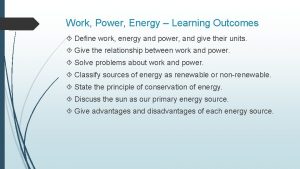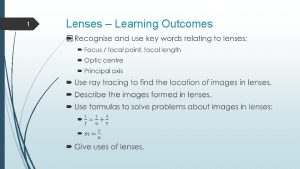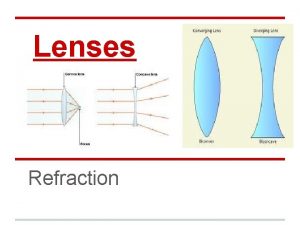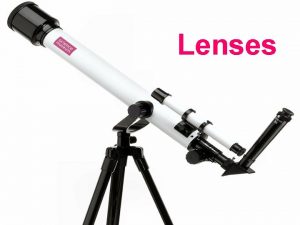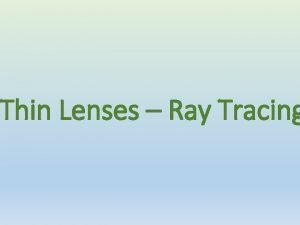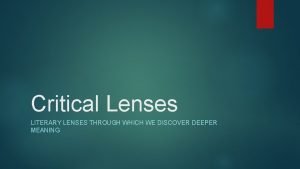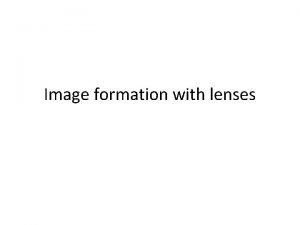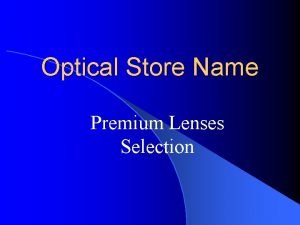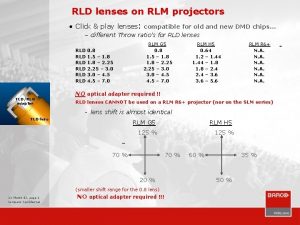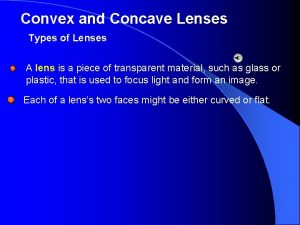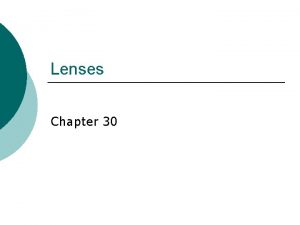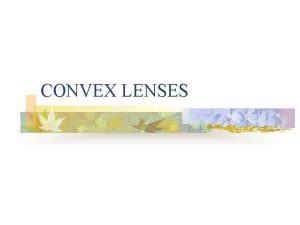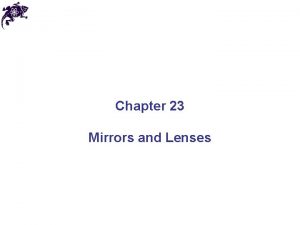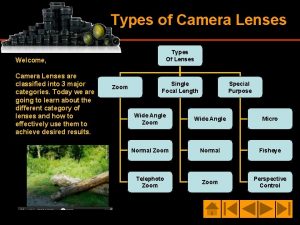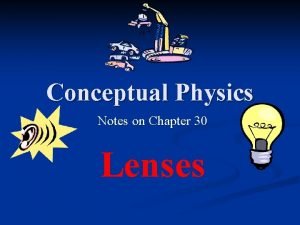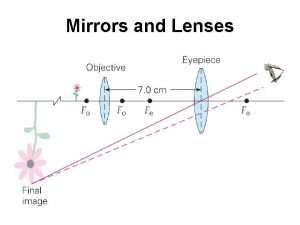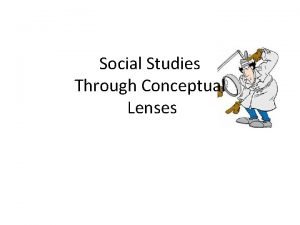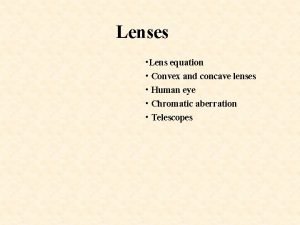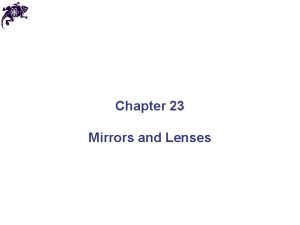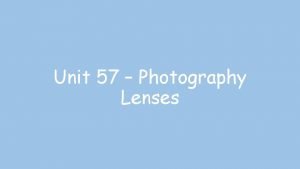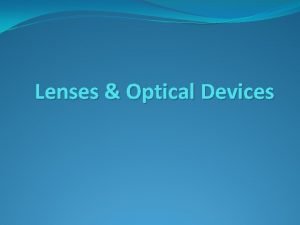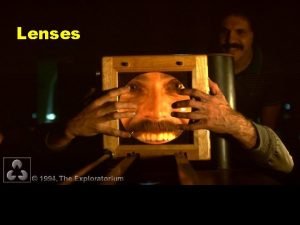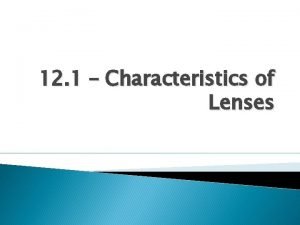1 Lenses Learning Outcomes 2 Lenses Learning Outcomes




























- Slides: 28

1 Lenses – Learning Outcomes

2 Lenses – Learning Outcomes

3 Lenses Convex lens (a. k. a. converging lens) Concave lens (a. k. a. diverging lens)

4 Convex Lenses – Ray Tracing A ray striking the optic centre will pass straight through the lens.

5 Convex Lenses – Ray Tracing A ray incident parallel to the principal axis will pass through the focus on the other side of the lens.

6 Convex Lenses – Ray Tracing A ray incident through a focus will emerge parallel to the principal axis on the other side of the lens.

7 Convex Lens – Images To focus an image of a distant object. 1. Use a bright distant object (e. g. a window in a dark room). 2. Face a convex lens towards the object. 3. Hold a piece of paper behind the lens and move it back and forth to focus the image. 4. If the object was very far away, the image will form at the focus behind the lens.

8 Convex Lenses – Images 1. An object outside 2 f. Image is: real inverted diminished between f and 2 f

9 Convex Lenses – Images 2. An object at 2 f. Image is: real inverted same size at 2 f

10 Convex Lenses – Images 3. An object between 2 f and f. Image is: real inverted magnified outside 2 f

11 Convex Lenses – Images 4. An object at f. Image is: at infinity

12 Convex Lenses – Images 5. An object inside f. Image is: virtual upright magnified behind the object

13 Concave Lenses – Ray Tracing A ray striking the optic centre will pass straight through the lens.

14 Concave Lenses – Ray Tracing A ray incident parallel to the principal axis will emerge as if it had come from the focus on the incident side.

15 Concave Lenses – Ray Tracing A ray incident towards the focus on the other side will emerge parallel to the principal axis.

16 Concave Lenses – Images An object anywhere in front of a concave lens will yield the same result – image is virtual, upright, diminished, and inside the focus.

17 Formula for Lenses

18 Lens Calculations e. g. An object is placed 40 cm from a convex lens of focal length 30 cm. Find the position and nature of the image. e. g. An object is placed 10 cm in front of a convex lens of focal length 20 cm. Find the position, nature, and magnification of the image. If the object is 3 cm high, what is the height of the image? e. g. An image which is four times the size of the object is formed in a convex lens of focal length 30 cm. Where must an object be placed if the image is real? What if the image is virtual?

19 Lens Calculations e. g. An object is placed 40 cm from a diverging lens of focal length 50 cm. Find the position and nature of the image. e. g. A concave lens of focal length 10 cm produces an image which is half the size of the object. How far is the object from the lens? Find the position and nature of the image.

20 Uses of Lenses Convex – magnify when object inside 2 f Magnifying glasses Spectacles (glasses) Telescopes, binoculars, microscopes etc. Concave Spectacles Camera lenses Door peepholes Telescopes

21 Power of a Lens

22 Power Calculations e. g. Find the power of: i. A convex lens of foal length 30 cm. ii. A concave lens of focal length 20 cm. e. g. Two convex lenses of power 5 m-1 and 8 m-1 are placed in contact. i. Find the power of the combination. ii. Find the focal length of the combination.

23 Power Calculations e. g. A object is placed 20 cm from a diverging lens, producing an image 10 cm from the lens. What is the power of the lens? e. g. A concave lens of power -0. 06 m-1 and a convex lens of power 0. 04 m-1 are placed in contact. i. Find the power of the combination. ii. Does the combination behave as a convex or concave lens?

24 The Eye The iris controls the amount of light entering the eye by varying the size of the pupil (the hole) The cornea, aqueous humour, lens, and vitreous humour all refract light. The lens has variable focal length, controlled by the ciliary muscles. By Rhcastilhos – public domain

25 The Eye The retina has three types of cones which detect red, green, or blue light and send signals to the brain. There are no cones around the optic nerve due to the density of nerves. This gives a “blind spot” where we have no vision. By Rhcastilhos – public domain

26 The Eye Due to the variable power of the eye’s lens, humans can focus on objects at different distances. This is called the power of accommodation of the eye. The lens has a maximum and a minimum power. Correspondingly, there is a shortest and farthest distance it can focus on. The shortest distance is called the least distance of distinct vision.

By Gumenyuk – CC-BY-SA-3. 0 27 Vision Defects Short-sightedness (myopia) is a defect of the eye that allows people to see nearby objects clearly, but cannot bring distant objects into focus. Normally, an image is brought to focus in front of the retina. This is fixed with a diverging (concave) lens.

By Gumenyuk – CC-BY-SA-4. 0 28 Vision Defects Long-sightedness (hyperopia) is a defect of the eye that allows people to focus on distance objects, but not nearby ones. Normally, an object would be brought to focus behind the retina. This is fixed with a converging (convex) lens.
 Learning outcome examples
Learning outcome examples Water cycle learning outcomes
Water cycle learning outcomes Notice writing learning objectives
Notice writing learning objectives Swot analysis objectives
Swot analysis objectives Nursery rhymes importance
Nursery rhymes importance Planning goals and learning outcomes
Planning goals and learning outcomes Photosynthesis takes place in
Photosynthesis takes place in Learning outcomes of nutrition in plants
Learning outcomes of nutrition in plants Domain 6 community linkages explanation
Domain 6 community linkages explanation Learning objectives of linear equations in one variable
Learning objectives of linear equations in one variable Learning outcomes generator
Learning outcomes generator Learning outcomes of direct and indirect speech
Learning outcomes of direct and indirect speech Purpose of learning outcomes
Purpose of learning outcomes Learning outcomes of input and output devices
Learning outcomes of input and output devices Mri ib psychology
Mri ib psychology How to write a reflective essay
How to write a reflective essay Learning outcomes of holy week
Learning outcomes of holy week Learning outcomes of holy week
Learning outcomes of holy week Headstart early learning outcomes framework
Headstart early learning outcomes framework Learning objectives of fruits
Learning objectives of fruits Gagne learning outcomes
Gagne learning outcomes Arithmetic sequence lesson plan pdf
Arithmetic sequence lesson plan pdf Lesson plan of a gift of chappals
Lesson plan of a gift of chappals Learning outcomes of work and energy
Learning outcomes of work and energy Sales and revenue are the same
Sales and revenue are the same Cooking learning outcomes
Cooking learning outcomes What is the difference between ncbts and ppst?
What is the difference between ncbts and ppst? Learning outcomes prescribe
Learning outcomes prescribe Learning objectives of work and energy
Learning objectives of work and energy



